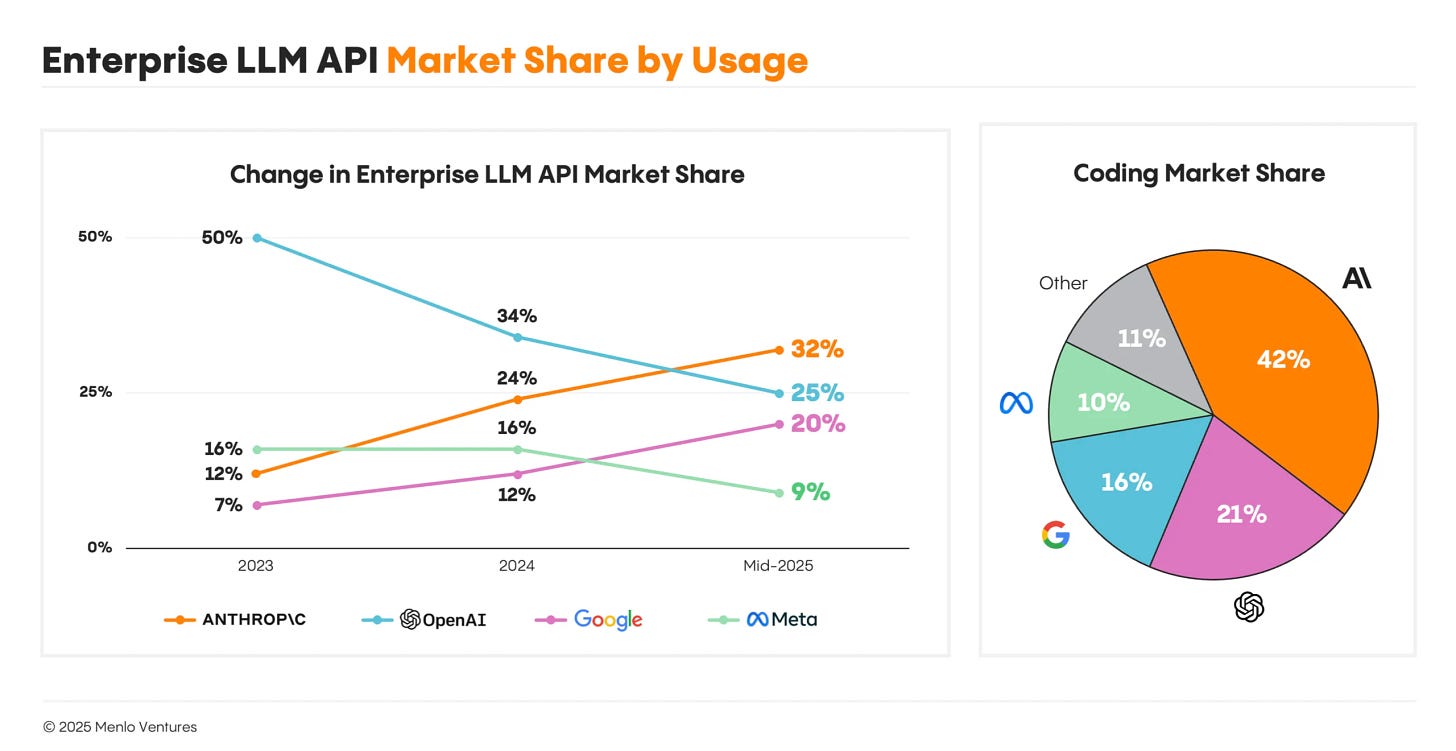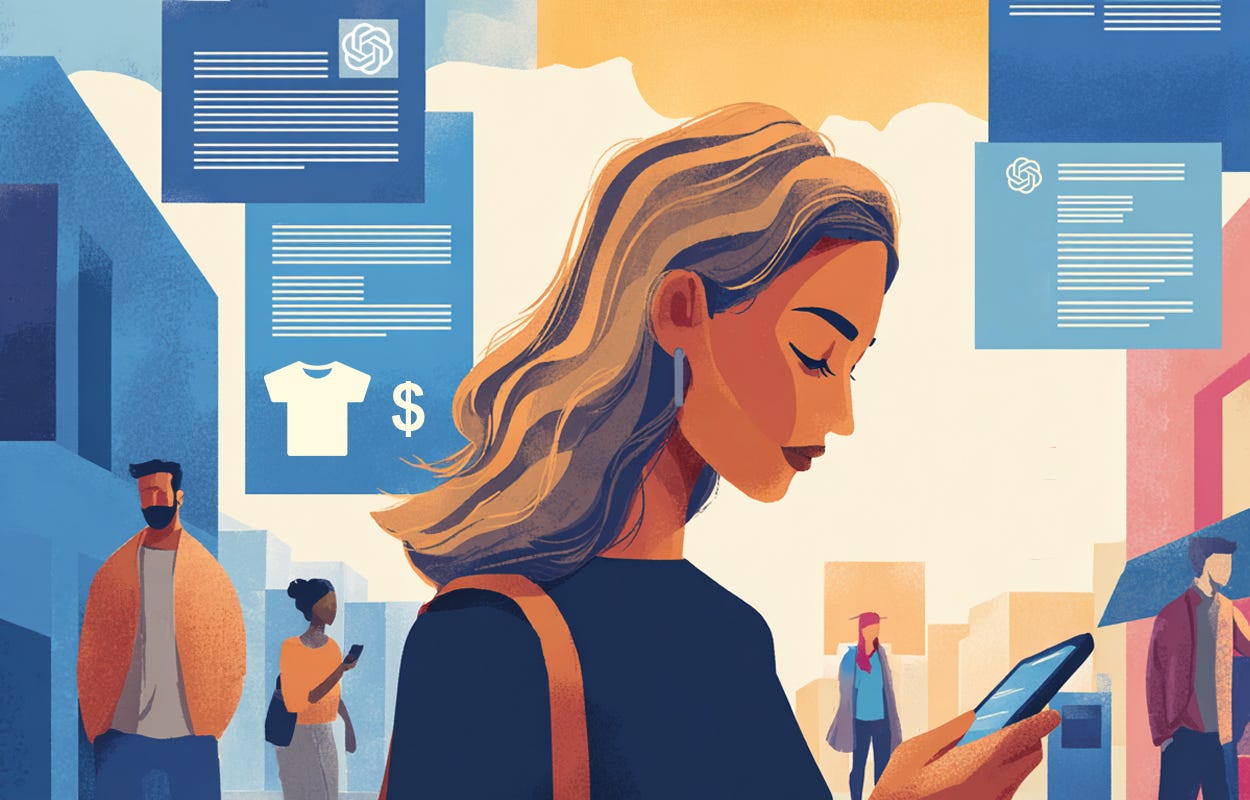OpenAI's Push for Moats and Profitability
Why OpenAI is launching a social media app, and bets on shopping and ads to turn 700 million users into revenue
AI breakthroughs don’t pay for themselves—and OpenAI knows it. With losses piling up and rivals close behind, the company has to do more than release ever-better models. It has to launch products on top of those models and convert as many as possible of its 700 million weekly active users into revenue.
This story looks at why OpenAI is moving beyond models—and how video, shopping, and ads could be its path to a sustainable business.
Sora 2, and OpenAI’s social media app for AI slop
This week, OpenAI released Sora 2, an improved version of its video-generating model. OpenAI pitches as a “ChatGPT moment for creativity,” promising to make video production as simple as writing a prompt.
The model now produces short clips with more consistent physics—objects bounce and float believably—and now generates synchronised dialogue, sound, and effects.
Judging by what people have created with it, Sora 2 looks impressive, and its outputs are comparable to Google’s Veo 3.
Early testers highlight the model’s ability to produce cinematic and anime-style scenes, though some clips still display unrealistic physics. Much of the most impressive content appears to come from Sora 2 Pro, a more capable version currently restricted to paying users.
Yet the bigger story isn’t just the model’s capabilities but the surprising decision to launch a dedicated social video app around Sora. This move comes just a week after Meta launched Vibes, a very similar app for AI-generated short videos, and months after Google introduced Veo into YouTube Shorts.
The invite-only Sora app, available in the US and Canada for now, offers a vertical feed of ten-second AI-generated clips. It prioritises friends’ content and encourages users to create rather than scroll passively. All clips carry visible and invisible watermarks.
To address the risk of deepfakes, the app introduces Cameo, a unique which lets users license their own likeness after a one-time verification and revoke its use at any time. The feature aims to give individuals control over when and how their image appears in AI-generated content.
Still, the launch has raised concerns. Social media is already linked to addictive behaviour and engagement-driven harms. Adding AI, with its tendency toward sycophancy, its power to foster emotional attachment, and its ease at spreading misinformation, has amplified those worries.
Sam Altman has said OpenAI will monitor and prioritise user wellbeing, even pledging to discontinue the service if most users don’t feel their lives improve (we will have to see if OpenAI keeps this promise). In the same post, he described Sora 2 as the start of a “Cambrian explosion” in creative expression, while acknowledging the risks of addictive feeds and misuse.
Sora is an experiment and, as Sam Altman has pointed out, it is unclear where it will take OpenAI. The real bet is not on the model itself but on the platform—on building a network of creators and viewers that competitors can’t easily copy. That, more than better algorithms, could give OpenAI the moat it needs as it searches for a sustainable business model.
Moats and OpenAI’s path to profitability
For a long time, analysts were saying that there are no moats in AI. Even if someone releases a breakthrough model that sets a new state-of-the-art performance, the competition catches up quickly. Additionally, switching between different vendors is easy, making it hard to lock customers in.
By launching the social media app, OpenAI is trying to build a moat around Sora, where the AI model plays a key role, but it is not the product itself. The product is the social media platform, which aims to lock in creators and audiences. If OpenAI succeeds, then it can follow the same path that turned Facebook, Instagram and TikTok into multi-billion-dollar businesses.
OpenAI needs to figure out how to be profitable. The company is burning through billions of dollars just to keep its infrastructure running. OpenAI generated $4.3 billion in revenue in the first half of 2025—but lost $13.5 billion in the same period. Even though OpenAI projects to reach $12.7 billion in revenue in 2025 and $30 billion in revenue in 2026, it does not expect to become profitable until 2029.
However, OpenAI knows they have a big opportunity in its hands. On multiple occasions, OpenAI does not fail to mention that ChatGPT has 700 million weekly active users. That could be another moat. But only about 20 million are paying subscribers (as of April 2025), meaning the majority of users generate costs rather than income. Converting free users has proved difficult, and that’s why the company is now exploring other ways to monetise its users—from ads to commerce—in search of a business model that can support both its ambitions and its burn rate.
Get ready for ads in ChatGPT
There are signs that OpenAI is seriously considering introducing ads in ChatGPT. One of them was a job listing on OpenAI’s website seeking a Growth Paid Marketing Platform Engineer to build internal tools for campaign management, ad platform integration, and real-time attribution.
The move follows the hiring of Fidji Simo, former Instacart CEO and ex-Facebook executive, as OpenAI’s CEO of Applications. At Facebook, Simo helped shape the ad-driven business model that scaled News Feed, Stories, and Marketplace—exactly the kind of experience OpenAI needs to monetise its huge user base.
In a conversation with Decoder, ChatGPT head Nick Turley said the company has not ruled out ads but will need to be “thoughtful and tasteful” about how they’re introduced. Ads would have to be clearly labelled and designed to avoid the clutter and frustration that have plagued Google Search and YouTube.
The opportunity is significant. ChatGPT now functions as both a chatbot and a search engine: an Adobe survey found that 77% of users turn to it for search, and 24% go there first. Semrush's investigation also suggests growing referral traffic from ChatGPT to websites. If OpenAI can prove ads here are effective, it could capture a slice of Google’s $198 billion search-ad market. Even a 10% share—around $20 billion — would dramatically improve OpenAI’s path to profitability.
For OpenAI, ads aren’t just another revenue stream. The infrastructure required to deliver and optimise them could also support new monetisation layers, such as shopping recommendations, turning ChatGPT into a true profit engine.
ChatGPT as a shopping assistant
OpenAI is turning ChatGPT from a conversational tool into a place where users can shop and pay without leaving the chat. The new feature, called Instant Checkout, is OpenAI’s first step into what it calls “agentic commerce”—a future where AI not only helps people decide what to buy but also completes the transaction on their behalf.
Initially launched in the US for free, Plus, and Pro users, Instant Checkout lets shoppers purchase products from Etsy sellers directly in ChatGPT, with integration for more than a million Shopify merchants planned. Multi-item carts and global rollout are on the roadmap.
When users ask about a product, ChatGPT surfaces relevant suggestions from across the web. Items eligible for Instant Checkout show a “Buy” button; users confirm the order, shipping, and payment details, all without leaving the conversation. ChatGPT acts as an intermediary, passing encrypted data to the merchant, while fulfilment, returns, and customer service remain with the seller.
At the core of this system is the Agentic Commerce Protocol (ACP), co-developed with Stripe. ACP allows AI agents to connect with existing merchant systems securely and efficiently, lowering the barrier for adoption. OpenAI stresses that transactions require explicit user confirmation and that payment tokens are authorised only for the specific purchase.
Embedding shopping directly into ChatGPT could reshape how people buy online. Instead of starting on Google or Amazon, consumers may begin their journey in a chat window. If conversational agents become the main shopping interface, the companies behind them may emerge as powerful new gatekeepers in e-commerce.
OpenAI already faces competition. Google recently unveiled its own Agent Payments Protocol (AP2), aimed at standardising AI-driven payments, but it is still in early testing. OpenAI’s ACP is live today, giving it a head start.
OpenAI’s ambitions to become the personal AI
OpenAI is losing market share in the enterprise. A report from Menlo Ventures on the enterprise LLM market has found that OpenAI holds 25% of the enterprise market, only half of what it had last year. That put OpenAI in the second place, after Anthropic, which has a 32% share of the market. In the third place is Google, which, with 20% of the market, is very close to OpenAI. In coding-specific markets, Anthropic leads with 42%, while OpenAI holds 21% and Google 16%.

Enterprises bring steadier, higher-value contracts, but OpenAI sees a larger prize on the consumer side. The company already serves around 700 million weekly active ChatGPT users, yet most are on the free tier and represent a cost rather than a source of income. Converting them into $20-per-month subscribers has been slow, so OpenAI is experimenting with other ways to monetise that scale—from ads to commerce.
The long-term vision appears to go even further: to become the default personal AI. OpenAI has partnered with designer Jony Ive to develop a hardware device that could one day replace smartphones. The recently launched ChatGPT Pulse, a Pro-tier feature that delivers daily personalised updates based on a user’s chats and connected apps, is a step towards that direction. The main rival in this space is Meta, where Mark Zuckerberg is betting on his own vision of “Personal Superintelligence.”
All these moves confirm a larger shift. OpenAI is no longer just a research lab chasing AGI. It is becoming a product company that needs to monetise its technology at scale—not only to fund the development of new models but also to justify the tens of billions already invested and the hundreds of billions it seeks for Sam Altman’s vision of “abundant intelligence.”
Thanks for reading. If you enjoyed this post, please click the ❤️ button or share it.
Humanity Redefined sheds light on the bleeding edge of technology and how advancements in AI, robotics, and biotech can usher in abundance, expand humanity's horizons, and redefine what it means to be human.
A big thank you to my paid subscribers, to my Patrons: whmr, Florian, dux, Eric, Preppikoma and Andrew, and to everyone who supports my work on Ko-Fi. Thank you for the support!
My DMs are open to all subscribers. Feel free to drop me a message, share feedback, or just say "hi!"




